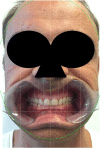Fully digital workflow, integrating dental scan, smile design and CAD-CAM: case report
- PMID: 30086753
- PMCID: PMC6081948
- DOI: 10.1186/s12903-018-0597-0
Fully digital workflow, integrating dental scan, smile design and CAD-CAM: case report
Abstract
Background: This report is a presentation of a clinical case that follows a full digital workflow.
Case presentation: A 47-year old man presented with pain in the TMJ (temporomandibular joint) and whose aesthetic concern was having a chipped maxillary central incisor veneer. The concern was solved following a fully digital workflow: it was applied the digital smile design protocol, as well as CAD-CAM monolithic lithium disilicate ceramic veneers and crowns (following a minimal invasive preparation approach). The aim of this rehabilitation was to solve a loss of vertical dimension, subsequent aesthetics and temporomandibular joint disorders.
Conclusion: Thanks to the evolution of technology in dentistry, it is possible to do a full digital case and solve problems such as loss of vertical dimension successfully. Nevertheless, more clinical studies are needed to obtain consistent results about the digital work flow compared to the conventional technique in loss of vertical dimension cases.
Keywords: 3D printer; CAD-CAM; Digital planning; Digital smile design; Digital workflow; Intraoral scanner; Minimal preparation; Monolithic lithium disilicate ceramic.
Conflict of interest statement
Ethics approval and consent to participate
Not applicable.
Consent for publication
Written informed consent was obtained from the patient for publication of this Case report and any accompanying images. The patient signed the consent to allow us to publish the case. A copy of the written consent is available for review by the Editor of this journal.
Competing interests
The authors declare that they have no competing interests.
Publisher’s Note
Springer Nature remains neutral with regard to jurisdictional claims in published maps and institutional affiliations.
Figures

















References
-
- Coachman C, Van Dooren E, Gürel G, Landsberg CJ, Calamita MA, Bichacho N. Smile design: From digital treatment planning to clinical reality. In: Cohen M, editor. Interdisciplinary Treatment Planning. Vol 2: Comprehensive Case Studies. Chicago: Quin- tessence; 2012. pp. 119–174.
Publication types
MeSH terms
LinkOut - more resources
Full Text Sources
Other Literature Sources
Medical
Miscellaneous

